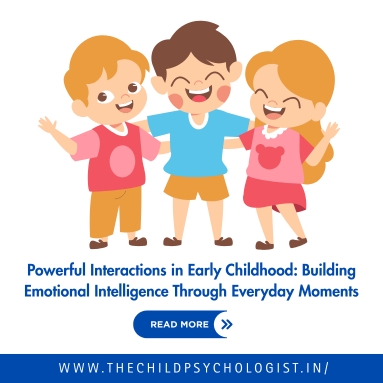By Dr. Vini Jhariya | Child & Clinical Psychologist | Founder, Urjasvini Child Development Center
Think back to a teacher who left a lasting mark on your life.
Was it their gentle smile, their kind words, or simply the way they made you feel seen and supported?
These moments weren’t just kind gestures — they were powerful interactions. In early childhood, these daily exchanges between adults and children are more than just communication; they are the foundation of emotional intelligence, trust, and future learning.
In this blog, we’ll explore how early educators — and even parents — can intentionally use everyday interactions to foster emotional growth, confidence, and resilience in young children.
Powerful interactions are purposeful, emotionally attuned moments that go beyond routine teaching. They build brain development, trust, and emotional safety — all essential for healthy childhood development.
Why Every Interaction Matters
Being an educator or caregiver isn’t just about routines or delivering lessons. Your presence, tone, and emotions matter just as much.
Whether it’s:
- A warm “Good morning”
- Sitting quietly beside a child, feeling left out
- A simple “I noticed you worked hard on that”
These small yet intentional acts shape a child’s self-esteem, emotional safety, and sense of belonging. Many child behavioral therapists emphasize that children build emotional regulation skills through real-life modeling, not just verbal instruction.
Emotional Intelligence: Modeled, Not Taught
Emotional intelligence (EI) is the ability to recognize, understand, and manage our emotions — and help others do the same. In early childhood, this skill is built through interactions, not worksheets.
As a teacher or caregiver, you are your child’s emotional mirror.
Educators and caregivers with strong EI:
- Create emotionally responsive classrooms
- Help children navigate strong feelings like frustration or sadness
- Reduce anxiety and behavioral outbursts
- Lay the groundwork for self-control, empathy, and learning success
These qualities are also what make someone the best child therapist — emotionally aware, nurturing, and responsive to a child’s needs.
What Are Powerful Interactions?
A powerful interaction is a moment when the adult is:
- Fully present
- Emotionally tuned in
- Focused on the child’s development
These moments are:
- Intentional — You respond thoughtfully, not automatically
- Validating — You recognize the child’s feelings
- Learning-centered — You guide without pressure
Even a 10-second interaction can shape how a child sees themselves and others.
Why It Matters
Children who experience regular, emotionally rich interactions tend to:
- Develop better language, memory, and focus
- Show empathy in peer relationships
- Build resilience and motivation
- Feel more secure, confident, and connected
In the view of many child behavioral therapists, consistent emotional support is as impactful as formal therapy, especially in early childhood classrooms.
How to Foster Powerful Interactions in Your Classroom
1. Build Strong Relationships
- Use descriptive language: “You stacked those blocks so high!”
- Acknowledge emotions: “You look upset — do you want to talk about it?”
- Show curiosity: “What made you pick that color?”
2. Support Learning Through Conversation
- Extend thinking: “What could we add to make it taller?”
- Introduce new words: “This is ‘balancing’ when the tower doesn’t fall.”
- Invite wonder: “What animals might we see in the garden today?”
3. Be Intentionally Present
Pause before responding.
Make eye contact.
Let your body language say, “You matter to me.”
Practical Tips for Teachers & Caregivers
- Be Authentic: Children connect with real people. Laugh, share, and be yourself.
- Take Care of Yourself: A calm adult creates a calm space. Don’t forget your emotional health.
- Observe Behavior: Children show feelings through actions — watch, reflect, respond.
- Seek Feedback: Ask colleagues to observe and reflect with you.
- Set Small Goals: One meaningful interaction a day can spark big changes over time.
Your Presence is Powerful
In early childhood, teaching isn’t just about learning the alphabet or numbers — it’s about helping children feel seen, valued, and safe.
When you choose to pause, reflect, and connect with intention, you’re not just teaching — you’re shaping lives.
And sometimes, the greatest therapy a child receives comes not in a clinic, but through your compassionate, everyday presence.
